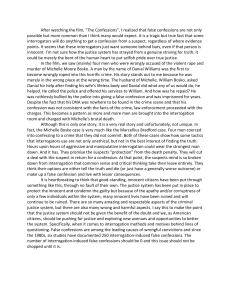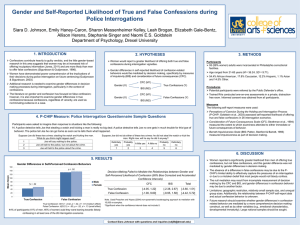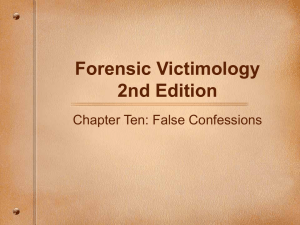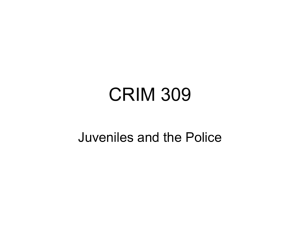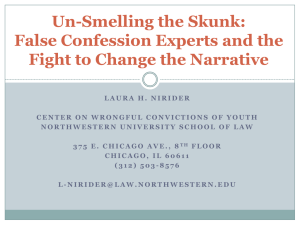Critical Thinking and Journal Articles
advertisement
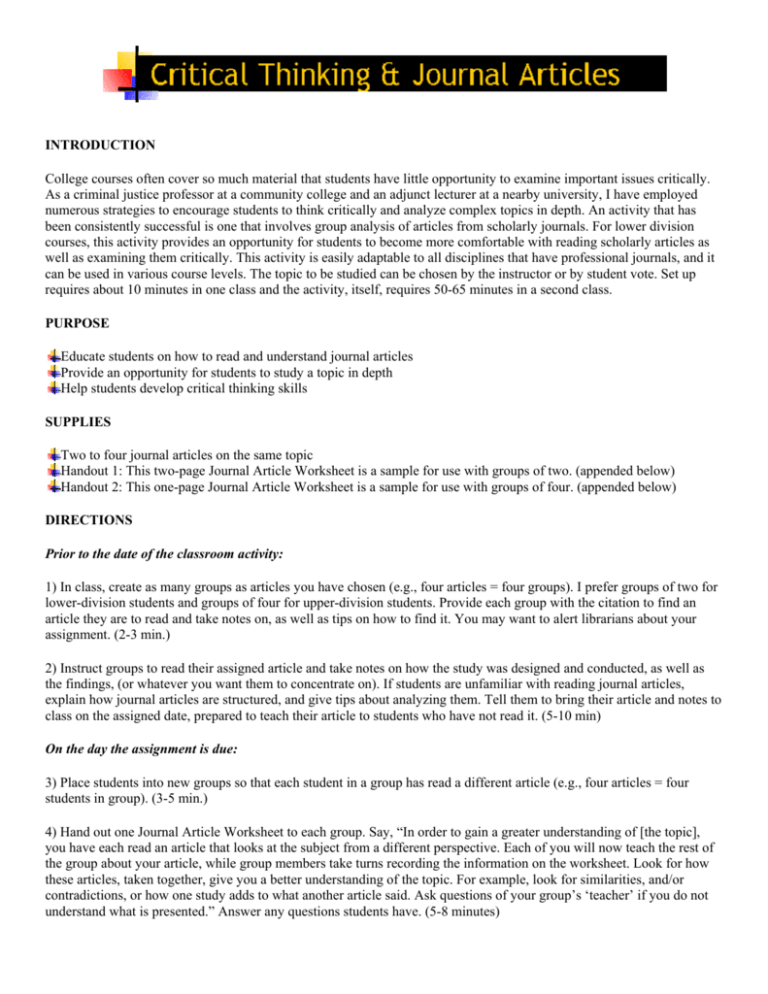
INTRODUCTION College courses often cover so much material that students have little opportunity to examine important issues critically. As a criminal justice professor at a community college and an adjunct lecturer at a nearby university, I have employed numerous strategies to encourage students to think critically and analyze complex topics in depth. An activity that has been consistently successful is one that involves group analysis of articles from scholarly journals. For lower division courses, this activity provides an opportunity for students to become more comfortable with reading scholarly articles as well as examining them critically. This activity is easily adaptable to all disciplines that have professional journals, and it can be used in various course levels. The topic to be studied can be chosen by the instructor or by student vote. Set up requires about 10 minutes in one class and the activity, itself, requires 50-65 minutes in a second class. PURPOSE Educate students on how to read and understand journal articles Provide an opportunity for students to study a topic in depth Help students develop critical thinking skills SUPPLIES Two to four journal articles on the same topic Handout 1: This two-page Journal Article Worksheet is a sample for use with groups of two. (appended below) Handout 2: This one-page Journal Article Worksheet is a sample for use with groups of four. (appended below) DIRECTIONS Prior to the date of the classroom activity: 1) In class, create as many groups as articles you have chosen (e.g., four articles = four groups). I prefer groups of two for lower-division students and groups of four for upper-division students. Provide each group with the citation to find an article they are to read and take notes on, as well as tips on how to find it. You may want to alert librarians about your assignment. (2-3 min.) 2) Instruct groups to read their assigned article and take notes on how the study was designed and conducted, as well as the findings, (or whatever you want them to concentrate on). If students are unfamiliar with reading journal articles, explain how journal articles are structured, and give tips about analyzing them. Tell them to bring their article and notes to class on the assigned date, prepared to teach their article to students who have not read it. (5-10 min) On the day the assignment is due: 3) Place students into new groups so that each student in a group has read a different article (e.g., four articles = four students in group). (3-5 min.) 4) Hand out one Journal Article Worksheet to each group. Say, “In order to gain a greater understanding of [the topic], you have each read an article that looks at the subject from a different perspective. Each of you will now teach the rest of the group about your article, while group members take turns recording the information on the worksheet. Look for how these articles, taken together, give you a better understanding of the topic. For example, look for similarities, and/or contradictions, or how one study adds to what another article said. Ask questions of your group’s ‘teacher’ if you do not understand what is presented.” Answer any questions students have. (5-8 minutes) 5) Have students begin teaching. Circulate around the room, answering questions or making suggestions. (10-20 min., depending on group size) 6) Tell them, “Now write a couple of paragraphs synthesizing what you have learned. Consider whether or not you now have a better understanding of the topic. Think of questions you would pose for further study of this topic.” Have students do this individually or as a group. (10-15 min.) 7) Lead a discussion on the topic, making sure that each group contributes. Have students identify the key points, and ask questions to draw out points you want to make. If you intend to test them on the information, list the main points on the board. Another option is to have the groups create test questions themselves. (10-15 min.) 8) If this is a graded assignment, collect the notes and worksheets. EXPERIENCES Both upper- and lower-division students usually come prepared and tend to enjoy the role of teaching their fellow students. In a recent ethics class, the students were studying the fact that some people falsely confess to crimes they did not commit. Half the class read an article detailing a study that showed that law enforcement officers did not spot false confessions as easily as college students. The other half of the class read an article proposing how the system can be improved to avoid false confessions. When they paired up to teach each other their articles, I heard a student who was taking notes say, “You mean police are more likely than college students to believe a false confession, and they are more confident they are right? I can see how that could be a problem.” I have also used this activity in an upper division course where students have read four articles on when juveniles should be tried as adults for crimes they commit. As I moved around the room to answer questions, I heard comments such as, “This article shows how the juvenile’s brain is not fully developed until the late teens or later.” Followed by, “Isn’t that important in whether the kid understood what he was doing?” Most students actively participate in the discussions both in the groups and during the general discussion. Students ask questions of one another on material they did not understand.The only problem I occasionally run into is the few who do not read the article. I allow them to be part of a group, but they do not get credit for the preparation work—their notes that they have to turn in. OUTCOMES My first goal for this activity is that students learn how to read and understand a journal article. A few students in the ethics class commented that they thought law review articles would be hard to understand, but they weren’t. When asked if they would feel comfortable using law review articles in their paper at the end of the semester, they said that now they would, whereas before reading the article, they would not have known how to read and understand the articles. My second goal was for students to have a deeper understanding of a course topic. When asked what they learned, many students were able to discuss the overall topic in a more informed manner. In fact, students who studied as a group, when compared to students in previous classes who received only lectures, did better on the same exam questions. My third goal for students was to help them develop critical thinking skills. Evidence suggesting success here occurs when students offer further questions for research or draw important conclusions from their deliberations. In the ethics class, for example, one student very correctly pointed out why the experiment with police officers and students might have different results if the experiment had been conducted differently. In response, another student said, “That may be true, but this shows there is a problem, and the other article pointed to a bunch of ways police can get a false confession. Together that is pretty scary.” In the juvenile delinquency class, the critical thinking was on an even higher level, where one student commented that, “I had no idea that elected officials influenced the opinions of judges and prosecutors about transfer to adult court. They send juveniles to adult court even though they are less likely to get rehabilitated there. And all because they want to look tough on crime. That’s messed up.” LESSONS LEARNED I learned that students of all levels are capable of understanding, critically evaluating and synthesizing the content of numerous scholarly articles. And the more practice they have at it, the better they get (and for newer students, the less anxious they are about using articles in a paper). I will continue using this strategy in many of my classes. I appreciate the flexibility of the activity, so that it can be tailored to the skill level of the particular class, the amount of time allotted for the activity, and how in-depth the instructor wants to take the task. SUPPORT MATERIALS Handout 1: Sample Journal Article Work Sheets for Two Articles (3 pages) Group _________________________________________________________________ Date_____________ Page 1: Ethics—“Honesty is the Best Policy: A Case for the Limitation of Deceptive Police Interrogation Practices in the United States ” The article compares the US system with the British system regarding what is allowed in interrogations. The standard in the US is whether, based on the totality of the circumstances, the conduct of the officers was such as to “overbear” the subject’s will to resist, and thereby bring about a confession that “was not the product of a rational intellect and a free will.” In short the court uses a “voluntariness” standard. 1. What is the author’s criticism of this standard? What standard is used in Britain , and why does he argue that this approach is better? 2. What does the author say are the costs of deception in interrogation? 3. What recommendations does the author suggest as a solution? Page 2: Ethics—“’I’d Know a False Confession if I Saw One’: A Comparative Study of College Students and Police Investigators” 1. How was the study designed (how was it set up, who were the participants, and what were the questions they wanted to find answers to)? 2. What were the results of the study (what did they find out about the differences between students v. investigators, and investigators who were highly trained in interrogation v. those who were not)? Page 3: SYNTHESIS of both articles: After discussing the two articles, write about what these articles, taken together, tell us about law enforcement’s role in false confessions and how the system can be changed. Recognizing that these are just a small sample of all the articles, what have you learned about the topic, and what questions do you still have? Handout 2: Sample Journal Article Work Sheet for Four Articles (1 Page) Group members ______________________________________________________ Date_____________________ In the boxes below, record the major points/significant issues of each article about Juvenile Delinquency Reconsidering Child Saving Juvenility and Punishment (Im)maturity of Judgment in Adolescence Waiving Juveniles to Criminal Court SYNTHESIS: After discussing each of the four articles, think about what they have in common, and what the differences are. Write about what these articles, taken together, tell us about waiver of juveniles to adult court. Recognizing that these are just a small sample of all the articles, what have you learned about the topic, and what questions do you still have? What would you suggest for further research? --Catherine Eloranto, Faculty, Criminal Justice, Clinton Community College, NY

